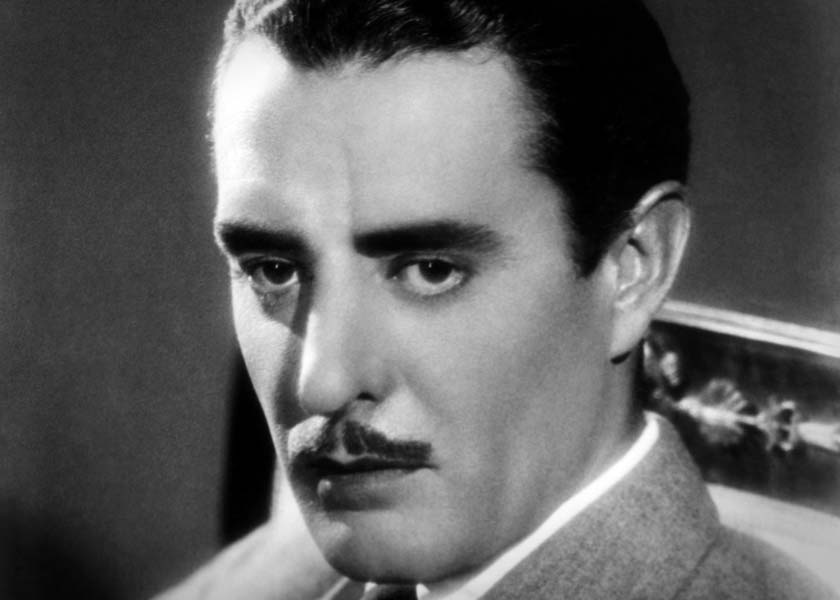At the apex of his career, John Gilbert was a movie superstar, the leading male actor at MGM Studios, and an acclaimed screen lover. He reached stardom in 1924 at age 28, but his stardom faded in 1930 after his first two disastrous talkies.
Early Career
John Gilbert was born July 10, 1897, in Logan, Utah. His parents were actors, and he made his stage debut at an early age. He appeared in his first film, uncredited, in 1915. From 1916 through 1920, under the juvenile name Jack Gilbert, he had supporting roles in over 40 films. He had his first lead in Shame (1921) for Fox Film Corporation under his mature name of John Gilbert. He starred in 21 films for the Fox Film Corporation from 1921 to 1924, including Monte Cristo (based on Alexandre Dumas' The Count of Monte Cristo), in which he played the hero, Edmund Dantes. Only two of his Fox films are known to still exist, Monte Cristo (1922) and Cameo Kirby (1923).
MGM & Stardom
Gilbert joined the new Metro-Goldwyn-Mayer Studio in 1924 and had a supporting role in the studio's first release, He Who Gets Slapped (1924), starring Lon Chaney. Gilbert was the star of seven other films in 1924, two of them directed by King Vidor: His Hour and Wife of the Centaur.
John Gilbert emerged as a major movie star in 1925 with the release of Vidor's The Big Parade (1925), one of the most popular and profitable films of the 1920s. Gilbert next starred with Lillian Gish in Vidor's La Bohéme (1926). The Merry Widow (1925), directed by Eric von Stroheim and co-starring Mae Murray, was another highly-praised box office smash.
Garbo & Superstardom

In 1926, after the moderately successful Bardelys the Magnificent (another collaboration with Vidor), Gilbert reached superstardom with his first film co-starring Greta Garbo, the hugely popular Flesh and the Devil, directed by Clarence Brown. The sizzling love scenes between Gilbert and Garbo (which rumor suggested were repeated offscreen) thrilled the moviegoing public. His second film with Greta Garbo, Love (1927), a version of Leo Tolstoy's 1877 novel Anna Karenina (but with a tacked-on happy ending), was another smash hit. Gilbert's final silent film with Garbo was A Woman of Affairs (1928). Their collaboration was successful once again, and the movie was one of the top moneymakers of 1929.
In Man, Woman and Sin (1927), Gilbert had the opportunity to play a different kind of character. The film, which co-stars Gilbert and renowned stage actress Jeanne Eagles, stresses his character's relationships with the heroine and his mother. Gilbert's character is shy and retiring rather than his standard virile and amorous archetype. Gilbert's other late-period silents, with co-stars such as Rene Adoree and Joan Crawford, were well-received and profitable.
During 1928 and 1929, when he appeared in nine more films (including an uncredited cameo in Show People, his sixth and final collaboration with King Vidor), Gilbert was the most popular male star at MGM. Readers of fan magazines such as Photoplay rated him one of the most popular leading men in films.
Sound Films & Decline
John Gilbert's great popularity declined rapidly after the advent of sound films.
By the end of 1930, he had made three consecutive flops and had irretrievably lost
his superstar standing. Gilbert's fall is often attributed to one of two causes:
that Gilbert had a high-pitched voice, or that he was deliberately sabotaged by
MGM boss Louis B. Mayer. The former theory describes Gilbert's voice as
high-pitched, approaching falsetto, possibly due in part to the poor quality
recording equipment of the time. The abnormal pitch thus made his ardent
lovemaking absurd rather than exciting, and Gilbert was laughed off the screen.
The latter conspiracy theory
suggests that Louis B. Mayer, the head of MGM,
disliked Gilbert and sabotaged him with poor scripts and directors. In fact,
neither theory is well supported by the evidence.
Gilbert's first sound film, The Hollywood Revue of 1929 (1929), was
an all-star production. In his brief scene with Norma Shearer, Gilbert's speaking
voice is in the average male range, perhaps rather flat and nasal, but certainly
not high-pitched. And if Mayer did indeed sabotage Gilbert, it was not by means of
low budgets, as MGM supported his initial sound films with expensive productions.
Indeed, much of the blame for Gilbert's meteoric descent may be attributed to
Gilbert himself. Graceful and emotive in his silent films, Gilbert is rigid and
uptight when working with sound, and displays an extremely poor command of spoken
dialogue in His Glorious Night (1929), his first released sound film.
In the film, Gilbert's speaking voice is regular if slightly weak. However, his
delivery is poor; he speaks in an affected, unnatural pattern. His acting is
stilted and tense. Despite a large budget, the film is poorly made, with inferior
dialogue, weak performances, and many long, static takes.
Lionel Barrymore, the film's director, lacked
experience. He had directed a few films before 1920, but had made only two talking
pictures prior to His Glorious Night. The trade paper
Variety noted that the lovemaking highlighted by Gilbert's repetition of
the phrase I love you
caused the girls in the audience to giggle. The film
was not a failure, but it received a tepid reception.
Gilbert's second talkie, Redemption (1930), based on the play The Living Corpse by Leo Tolstoy, was actually made before His Glorious Night, however the film's release was delayed, probably due to its poor quality. Despite a lavish production, direction by silent film veteran Fred Niblo (with uncredited retakes by Lionel Barrymore), and a cast including silent favorites Renee Adoree, Eleanor Boardman and Conrad Nagle, Redemption is dull, unconvincing, and gloomy. Gilbert's delivery of dialogue is pretentious and declamatory. Unsurprisingly, the film was a commercial flop.
The poor quality of these two films may seem outwardly to reinforce the theory that Gilbert's career was deliberately sabotaged with inferior stories and directors. However, MGM entrusted director Lionel Barrymore with several important actors and films including a Ruth Chatterton vehicle, Madame X (1929), and The Rogue Song (1930), the first film of famed singer Lawrence Tibbett, who the studio had signed to an expensive contract. Fred Niblo, the director of Redemption, had been successful with silent films (including the 1925 version of Ben Hur), and could reasonably have been expected to be successful with talking films, and MGM tried to give Gilbert a strong and meaningful role for his first talkie. When that approach failed, Gilbert was given a role in His Glorious Night that was tailored to his screen image as a great lover. Unfortunately, that tactic also failed. Thus, it may be concluded that the poor quality of Gilbert's first talkies, and the irreparable damage they did to his career, was in no way calculated.
Final Films
By 1930, film styles and audience tastes had changed significantly from the romanticized silent films in which Gilbert had starred. His screen image was out of date. His third talking picture, Way For a Sailor (1930), was an attempt to toughen his image. However, his portrayal does not fit the character. Gilbert's films continued to sink at the box office. He complained to the studio about the stories in his films, finally writing his own scenario for Downstairs (1932), in which he plays an unscrupulous chauffer.
Gilbert's contract with MGM, signed at the apex of this popularity and worth $250,000 per film, finally expired in 1933 after the release of several routine pictures. In four years, Gilbert had declined from superstardom to the lead in second-features. Greta Garbo demanded Gilbert as her costar in Queen Christina (1933). Gilbert's acting is adequate, and the film was a moderate success, but it did not help his career. Queen Christina was Gilbert's last film at MGM.
The final film of his career, The Captain Hates the Sea (1934), a low-budget variation on Grand Hotel (1932) in which Gilbert plays a drunken writer observing his fellow passengers on a cruise ship, was made at Columbia Studios.
Wives & Love Affairs
Gilbert had four wives, including actresses Leatrice Joy (1922-1925), Ina Claire (1929-1931) and Virginia Bruce (1932-1934). He also had well-reported affairs with Greta Garbo and Lupe Velez. The fans were thrilled by the stories of his romance with Garbo. Some versions of their love affair depict Garbo leaving Gilbert literally waiting at the alter. Divorced at the time of his death, Gilbert had been escorting Marlene Dietrich for several months.
Final Years & Death
Gilbert was known as a difficult actor to work with. He was a heavy drinker, and his alcoholism increased as his career waned. He lived two years after making his final film, The Captain Hates the Sea. Portraits from his final years show physical decline. His face becomes progressively thinner, with sagging skin and drooping eyelids. He suffered a severe heart attack in 1935 that permanately damaged his health.
John Gilbert died of a second heart attack at his home in Beverly Hills on January 9, 1936. He was 38.
Career Consideration
Gilbert is representative of the best of silent film acting. His technique is subtle, but strong, and his meaning is easily interpreted. In a silent film, strong emotions are expressed to the viewer by simple means. The best silent films are romantic and highly expressive. Without voice to transmit meaning, the viewer is supplied words more from the facial and body movements of the actors than from the subtitles. Gilbert was an expert at this style, and modern audiences still respond strongly to him.
Sound films changed acting styles. Meaning is carried in the words and the way the words are spoken. Facial and body expressions support, rather than transmit, meaning. Although Gilbert's voice was not the falsetto of legend, he was nonetheless unable to deliver dialogue effectively. As a result, Gilbert was unable to project the charisma, virility, and strength of characterization that made him a star of silents into his speaking parts.
The types of roles in which he had specialized were out of date in 1930. Stories about love and love affairs had not ended, but the highly romanticized variety of story was finished. Even if Gilbert had been competent with his spoken lines (and, perhaps, supplied with better lines to speak), His Glorious Night might still have flopped for being outdated.
Although still young, Gilbert seemed to age rapidly. New actors, more modern and attractive in style and appearance, replaced him as favored leading men. Greta Garbo extended Gilbert an olive branch with his final role in a major film, Queen Christina, yet Gilbert hardly rises to the challenge. He is adequate, but rather diminished, in the part.
Further Reading

